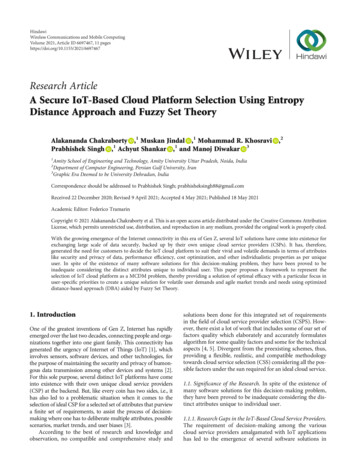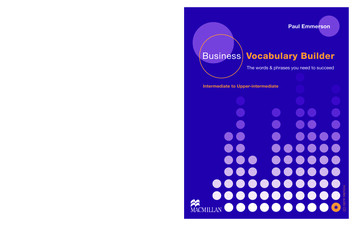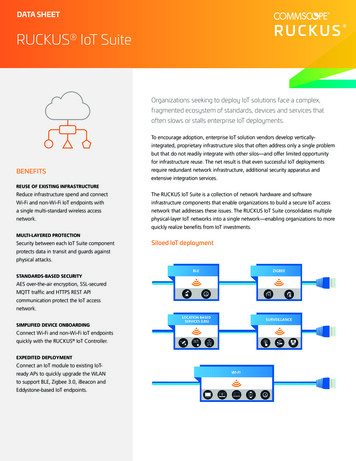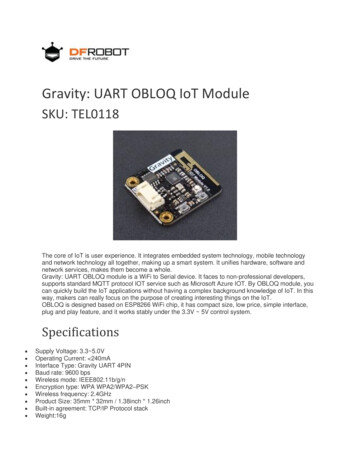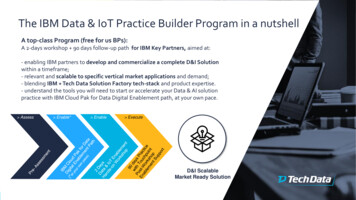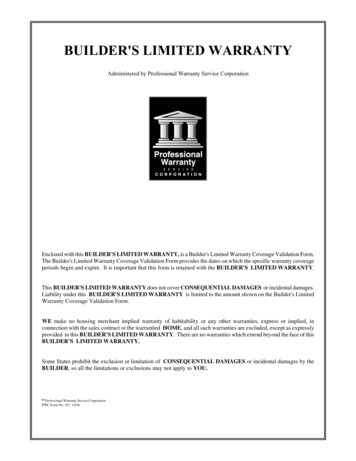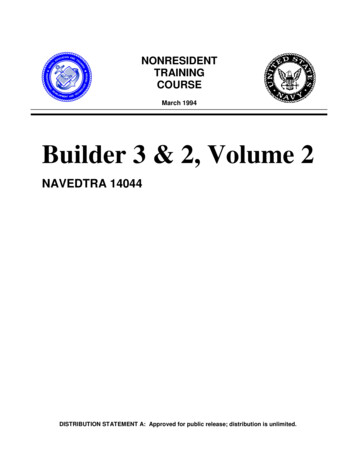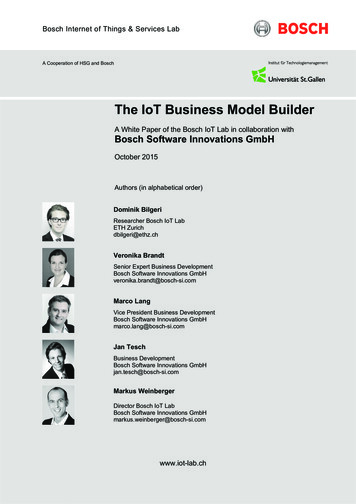
Transcription
Bosch Internet of Things & Services LabA Cooperation of HSG and BoschThe IoT Business Model BuilderA White Paper of the Bosch IoT Lab in collaboration withBosch Software Innovations GmbHOctober 2015Authors (in alphabetical order)Dominik BilgeriResearcher Bosch IoT LabETH Zurichdbilgeri@ethz.chVeronika BrandtSenior Expert Business DevelopmentBosch Software Innovations GmbHveronika.brandt@bosch-si.comMarco LangVice President Business DevelopmentBosch Software Innovations GmbHmarco.lang@bosch-si.comJan TeschBusiness DevelopmentBosch Software Innovations GmbHjan.tesch@bosch-si.comMarkus WeinbergerDirector Bosch IoT LabBosch Software Innovations ext eingeben]
1IntroductionThe Internet of Things is becoming more and more important in many domains. Because in many casesit has the power to create completely new value propositions, new business models1 have to bedesigned for new IoT solutions. In this paper we define business models according to Osterwalder andPigneur (2010) as “the rationale of how an organization creates, delivers and captures value.” Whilethere is extensive literature available related to business model innovation (e.g., Gassmann et al.,2014) and IoT-induced business opportunities (e.g., Fleisch et al., 2014), the IoT business model builderoutlined in this whitepaper provides a hands-on, easy-to-use procedure model for developing businessmodels for IoT offerings. It is based on our experience in designing business models for IoT applicationsin various domains.The paper is organized as follows: Chapter 2 explains what makes a specific approach for designingbusiness models in the IoT context necessary and elaborates on further advantages of the approachoutlined. Chapter 3 provides a short overview of the overall process, whereas Chapter 4 lists the tenprocess steps of the IoT business model builder that should be taken from generating opportunity ideasto evaluated business model scenarios. Depending on the current state of a project, one can “enter”the IoT business model builder at different stages; hence, it is possible to start with step 1 and theideation of promising IoT opportunity ideas or, in case a specific opportunity were to be selected andelaborated already, to start with step 6 and the identification of a stakeholder network, etc. Chapter 5focuses on the important aspects of following and validating the assumptions that were madethroughout the process. Best practices, tools, and methods that are recommended for applicationwithin the process are explained in Chapter 6. It is up to the moderator to choose from the providedalternatives depending on the specific case. A glossary of important terms can be found in Chapter 7.2Why a specific business model development approach?2.1 IoT specificsIoT offers unique opportunities in many fields. At the same time, a complex value stack needs to beaddressed in order to realize those possibilities. This induces specific requirements when it comes todesigning IoT business models. As a benefit of our approach, the following IoT-specific requirementsare being addressed:1. Extend scope beyondthe company level toecosystem levelIn most IoT scenarios, value creation happens within an ecosystem withmultidirectional value and service streams across the various stakeholdersinvolved (e.g., partners, customers, users). It is necessary to obtain a holisticview on all relevant stakeholders and their contributions in order to maximizevalue for the targeted stakeholders and establish shared values. Therefore, it isimportant to shift the focus from the company to the ecosystem level whendefining the business logic (see Westerlund et al., 2014).Table 1 (continued): Specific requirements for business modelling in an IoT context (own table)1Important terms that are used throughout the paper, incl. opportunity ideas are highlighted in italics the firsttime they are mentioned. They are described in more detail in each section or listed in the glossary in Chapter 7.Bosch IoT Lab Whitepaper 20151 Page
2. Supportdesign/visualization ofcomplex value streamswithin the stakeholdernetworkTraditional approaches to illustrate value chains fall short of capturing thevalue added in the context of IoT because they assume linear value chainsfrom suppliers to the focal company down to customers. Therefore, we neednew ways of illustrating the value added in the stakeholder network that allowfor identifying synergies and dependencies between the nodes.3. Explicitly consider thevalue proposition for allkey stakeholders (e.g.,users, customers, andpartners)To foster sustainability of value creation within a stakeholder network, it iscrucial that all contributing parties have incentives to participate in thenetwork. Therefore it is crucial to explicitly consider the value proposition forkey stakeholders in the early phases of business model development.4. Consider data as anasset within and beyondthe actual opportunity.As connected devices have the potential to capture a lot of data, werecommend following a structured approach when defining how to leveragethat data (either as value adding services within the same business model or insubsequent business models). This might include direct data monetization orother means of reusing information as assets in business models.Table 1: Specific requirements for business modelling in an IoT context (own table)Business model development usually begins with understanding customer needs and deriving acompelling value proposition. However, in many cases a specific context already exists – e.g., somecompanies work on questions concerning how rail cars will be connected and transmit sensor data,while in other cases the question might be how to draw more users/devices to an IoT platform. Thesevery context-driven cases require a structured approach to eliminate blind spots. As IoT solutionscontain usually both the “product” and “Internet” parts, we see two domains that need to be bridged:the machine camp and the Internet camp, associated with different mindsets and skills (see Slama etal., 2015, for more details). Common artifacts, e.g., templates or procedure models, can help to alignthese worlds.2.2 Further benefits of the IoT Business Model BuilderIn addition to addressing the specifics of IoT, our approach offers further advantages that we see asessential when developing business models. They are addressed in the following principles:Align business model to overall company strategy: To ensure strategic fit, we recommend validatingat an early stage whether and how the opportunity contributes to the overall company strategy. Thiscan be done in the idea selection phase, using checklists that represent key values or strategic goals ofthe company.Identify key drivers of value: We offer a user-centered approach when defining the IoT offering,starting by defining the value proposition and subsequently assessing which parts of the solution cancontribute to the value proposition.Assign tasks to stakeholders according to their capabilities: To minimize costs and efforts andmaximize value, use a resource-based view to allocate resources. Determine what capabilities arerequired for the IoT offering and which stakeholder can best bring them in.Bosch IoT Lab Whitepaper 20152 Page
Future-proof business model at an early stage: Consider how to ensure economic viability of thebusiness model as early as possible. Aspects might include property rights, technological skills,resources, or other competitive advantages.Document and validate assumptions that have an impact on the business model: Throughout theprocess of business model development, many assumptions are made. They can be related to allcomponents of the business model (target groups, market size, user acceptance, technical feasibility,costs, etc.). It is crucial to document them and to shed light on how much they affect the businessmodel. As it is impossible to eliminate uncertainty when making predictions about the future, werecommend at least making a classification of assumptions according to the degree of their uncertainty(in categories such as high/medium/low).3The IoT Business Model Builder approachIdeally, the IoT projects should be embedded in an overall enterprise IoT strategy; for further referencesee Slama et al. (2015). This paper focuses on the operational level from idea to business modelevaluation. For all opportunity ideas, the typical and seemingly simple question is “What is theappropriate business model for the idea?” Before a business model can be discussed, however, somequestions need to be clarified. In particular, it has to be clear whose business model for whichopportunity is to be designed.Several questions need to be answered to get from ideating initial, rough opportunity ideas to acompletely analyzed business model and business case as the basis for a management decision. Allwork packages can be seen as steps in the three phases of the generic business modeling processdepicted below in Figure 1: ideation, preparation, and evaluation. It is of course important to note thatthe process includes iterations within the above-mentioned steps as well as between the processphases.Figure 1: Phases of business modeling (adapted from Robert Bosch GmbH Corporate Department Business Models, 2015)The document at hand aims to both help practitioners perform the challenging steps when looking fora suitable opportunity as well as enable the development of business models for a promising new IoTsolution. The procedure and tools described here have been tested in previous case studies. Firstexperiences with the methodology at hand have shown that the process usually requires severalmonths, depending on the complexity of full execution. In addition, the procedure at hand will requirethe organization of certain resources (mostly time and workshop facilities) as well as ensuring theparticipation of diverse stakeholders within and outside the company.Bosch IoT Lab Whitepaper 20153 Page
4IoT Business Model BuilderAll steps below are part of a highly iterative process. Several steps might be combined into one workshop, depending on time and complexity. It might anyhowbe necessary to take the results of one step home for further discussion and analysis before continuing with a next step.Step/milestonePhase1. CreateopportunityideasWorkshopInputIoT missionstatementWork to be done – contentOutputParticipantsToolsWorkshop:Long list ofopportunities15–20 Brainstorm and cluster opportunity ideasGenericproduct orservice idea Different disciplinesExternal views frompartners orpotential customersIdeationIf applicable,strategicboundaryconditions2. Sketchopportunities2WorkshopLong list ofopportunities Workshop: 3. SelectopportunitiesWorkshopLong list of(sketched)opportunities Explain and discuss opportunity ideasIdeate value drivers that increase customers benefitsGain a common understanding of what ismeant by each opportunityWorkshop: Explain and discuss opportunity ideasAgree on selection criteriaSelect opportunitiesLong list of sketchedopportunities, valuedriversPreliminary short listof 2–3 opportunities(not more than 5)15–20 Different disciplinesExternal views frompartners orpotential customers15–20 Different disciplinesExternal views(partners, potentialcustomers) Creativitymethods (e.g.,random input,brainstorming)55 patterns (incl.digital componentextension)5 value-creationlayersAssumption list(see Chapter 5)IoT shamrockMapping valuedriversAssumption listDecision supporttoolsAssumption list2Step 2 “sketch opportunities” and step 3 “select opportunities” might change in sequence, depending on the actual situation, complexity of the topic, and workshop participants.Sometimes it could be helpful or even necessary to have a larger group of workshop participants who came up with the ideas also specify them. When the selection ofopportunities for further processing might come with strategic considerations that might not be shared with a large group of external participants step 2, then step 3On the other hand, it could be advantageous to first discard a number of unfeasible or unwanted opportunities to reduce the effort for specification step 3, then step 2.Bosch IoT Lab Whitepaper 20154 Page
PreparationIdeationPhaseStep/milestoneInputWork to be done – contentOutputParticipantsTools4. SelectopportunitiesHomeworkPreliminaryshort list of(sketched)opportunitiesHomework:Final short list of(sketched)opportunitiesCore team (see glossaryin Chapter 7) 5. Detail offeringfrom userperspectiveWorkshopFinal short list of Workshop:opportunities Detail the offering along the customerjourney Capture capabilities required to deliver theoffering Include potential users for a complete viewand validationDetailed short list ofopportunities15–20 participants (diff.disciplines)6. Analyzestakeholdernetwork for eachopportunityWorkshopDetailed shortlist ofopportunitiesStakeholder networkdiagram4Depending on the results of step 3 and on theparticipants and their decision power, it might benecessary to re-evaluate the opportunities andmake a final decision.Workshop:Find suitable answers to the following questionsfor each opportunity:3 What do stakeholders contribute?How do potential partners see their roles?Which participants in a stakeholder networkare necessary to implement the opportunityas specified?What is the value proposition forstakeholders? External views(partners/customers)15–20 participants (diff.disciplines) Decision supporttoolsAssumption listCustomer journeyCapabilityassessmentAssumption listStakeholdernetwork diagramAssumption listExternal views(partners/customers)3Stakeholder networks might look entirely different for different opportunities. For the “connected e-bike” idea, the network of the opportunity “theft protection” might includean insurance company, while bike dealers are part of a network related to a “preventive maintenance” opportunity.4Note: The stakeholder network will most likely be ambiguous.Bosch IoT Lab Whitepaper 20155 Page
PhaseStep/milestoneInputWork to be done – contentOutputParticipantsTools7. Select a focusnode /stakeholder fromthe mDecision:Stakeholder networkdiagram with focusnode/stakeholderCore team Business modelsketch (Osterwaldercanvas or St. Gallenmagic triangle) andbusiness case forfocus node /stakeholderCore team plus expertsrepresenting internaland external sources forrequired data (cost,expected revenues)Considering that each participant in the networkhas his own individual business model, it will beimportant to have a clear understanding ofwhose business model is to be analyzed. Stakeholdernetwork diagramAssumption listPreparationDepending on the case, it might make sense toselect more than one focus node and analyze thebusiness models and business cases for thosenodes in step 8 in parallel.8. Completebusiness modeland businesscase for thefocus node /stakeholderWorkshopStakeholdernetworkdiagram withfocus node /stakeholderWorkshop:The stakeholder network diagram alreadycomprises information about customer, valueproposition, partners/suppliers, and revenuemodel.During the workshop, the business model shouldbe refined and completed. Based on thestakeholder network and situation, alternativebusiness models (or alternative options forcertain aspects, e.g., revenue model) could beconsidered. St. Gallen magictriangleOsterwaldercanvas55 business modelpatterns (incl.digital componentextension)IoT business caseaspectsAssumption listBusiness models and stakeholder networkdiagrams provide information on what the nodehas to deliver (relates to its cost) and what hegets in return (revenues). Bosch IoT Lab Whitepaper 2015Set up a tool to calculate the business caseand decide which input data is necessaryCollect the required dataCalculate the business case.6 Page
EvaluationPhaseStep/milestoneInputWork to be done – contentOutputParticipants9. AggregateresultsWorkshop/homeworkArtifacts fromprevious stepsWorkshop/homework:Finalized stakeholdernetwork diagram;finalized businesscase for focusnode/stakeholderCore team10. BM kdiagram, list ofassumptions,business modeland businesscase for focusnode /stakeholder4 to 8 logicallydistinct but realisticscenarios in additionto original businessmodelCore team plus Validate/complete stakeholder networkdiagramConsistency check of business casesComplete assumptions validationAgree on next steps/roadmapPrepare management decisionsWorkshop/homework: For each assumption in the business case,determine the degree of potential impact ofchanges using, e.g., sensitivity analysisFurther, influencing internal and external(PEST) factors are determined and rankedaccording to the degree of uncertaintyCorrelations are determined and severalscenarios createdFurther, business cases for each scenario arecalculated and the ideal business model foreach scenario is schemed Controlling expertsScenario-planningexpertsTools Business modelscenario planningAssumption listBusiness case withevaluation of riskand return (ROI) –enhanced decisionbaseActionable plan forhow to counteractscenarios and alterthe business modeldesignTable 2: IoT business model builder (own table)Together, the output documents from all the above steps, especially the business case, business model (canvas or triangle), and the network diagram, provideall necessary data for a management decision.Bosch IoT Lab Whitepaper 20157 Page
5Business modeling and the importance of assumption validationBefore the tools recommended for the IoT business model builder are described in greater detail inthe next section, it is essential to gain a better understanding of how business modeling ideally works.Throughout the whole process, predictions about the world are made. The underlying assumptionsrequire testing/validation on an ongoing basis. We recognize that it is impossible to validate allassumptions; however we recommend making the degree of certainty of assumptions transparent.Uncertain assumptions with a high impact on the business case are candidates for scenario planningas outlined in step 10.Assumptions should be tracked throughout the whole process. It is crucial for the success of the projectto critically review and test assumptions at each of the remaining IoT business model builder steps.Assumptions might be related to Value propositionDemand and customers willingness to payUser behavior, user needsMarket conditionsTechnical feasibilityTechnical and organizational capabilitiesMotivation of network stakeholdersCostsThe IoT business model builder with its iterative character and various tools accounts for the potentialevent that certain assumptions are falsified. In such a case, it might be necessary to either specify theassumption in more detail or to conduct further tests including other sources of information. If thisfine-tuning is not successful, steps should be repeated and assumptions changed accordingly,resulting, for instance, in the choice of a different opportunity or an adapted definition of the valueproposition.When and how to validate assumptionsWe recommend a table format to organize the required assumptions in a structured way. After eachstep (alternatively, also after using a specific tool), one can agree on the key assumptions underlyingthe step outputs. The assumptions should then be added to a list, which is maintained consecutivelyalong the IoT business model builder steps displayed in Table 2. Apart from column one including theassumptions, the table could consist of further columns describing (1) how – i.e., based on what data(source) one intends to validate the assumption, (2) where to receive the relevant data (e.g., whoneeds to be contacted), (3) how long it will take to gather the relevant information, (4) whether theassumptions can finally be approved or rejected according to test/research outputs, (5) with whatdegree of uncertainty the questions are answered, and (6) what their overall impact on the businessmodel is. Table 3 is an example table with two generic assumptions.Use the time between workshops or working sessions to validate as many of the assumptions on thelist as possible. To do so, it is necessary to “get outside the building” and talk to relevant stakeholders.Potential means of collecting data (cf. Punjabi, 2013) for assumption validation includeBosch IoT Lab Whitepaper 20158 Page
Contacting stakeholders (e.g., consumers, potential partners, suppliers)Contacting experts related to assumptions (trend analysts, research institutions, etc.)Reviewing existing markets (i.e., competitors’ offerings, existing business models, etc.)Looking at industry reports, statistics (incl. public online sources such as Google Trends, etc.)Assessing sensitivities of changes towards assumptionsAssumptionThe digitallycharged product istechnically possibleCustomer-approvedvalue propositionHow to validate? Gather expert opinions Build prototype (proof of concept) Interview customers for theiropinions/estimationsLet customers test/use mock-ups,prototypes (observing them)Evaluate similar solutions on themarket & customer feedbackPotential sources Expert panels Engineeringteam Customerinterviews Experiments Desk research,surveys, etc.Time horizon3–4 monthsCheck 2–3 monthsUncertaintylowImpacthighhighhigh Table 3: Exemplary table with two selected assumptions (own table)As practice has shown, it is almost impossible to validate all assumptions with an ultimate degree ofcertainty about future developments. Aiming to develop business models in a field so innovative andnew – such as the IoT environment – will always come with risks. Therefore, it is highly important toreveal sources of risks. Figure 2 provides a supplementary graph illustrating the two columns“uncertainty” and “impact” listed in Table 3 above. During the first nine steps of the IoT business modelbuilder and the time between workshops, the assumptions still might “move across squares” (changetheir uncertainty and impact), especially as they become more validated and the business model getsmore refined. As indicated with the color scheme, actual risks lie in the fields close to the upper rightcorner, where assumptions remain critical uncertainties at the end of step 9, meaning that they havea high overall impact on the business model (case) and are highly uncertain.Figure 2: Impact and uncertainty of assumptions (own graph, adapted from Sharpe & Van der Heijden, 2007)Thus, while business model validation is in general important, the validation of certain assumptions isparticularly critical. Two examples are the value propositions for customers and ecosystemstakeholders, as indicated in Table 3 with high estimated uncertainty and impact. The lean-startupmethod offers good means to learn from customer feedback as early as possible. It is highlyrecommended to not only request conceptual feedback but also observe customer and stakeholderreactions based on first prototypes – i.e., minimal viable product versions (Punjabi, 2013).Bosch IoT Lab Whitepaper 20159 Page
Main purposes of assumption validation Manage risk by confronting assumptions with market reality from the start, thus increasingtransparencyIncorporate other stakeholders’ views (also external), which can help to think outside the boxSources and further in-depth literaturePunjabi (2013). Validate or Die: Using Validation to Build the Right Product. Accessed on July 31, t/6Recommended toolsThe following subsections describe the instruments recommended at each step in Table 2 above. Thesetools aim to guide practitioners through the entire process and help them at each step to focus on thecritical issues, encouraging procedure participants to develop new, “out-of-the-box” ideas. Figure 3illustrates the recommended tools to be used as part of the business model builder procedure.Figure 3: IoT Business model builder with recommended tools (own graph)In order to ensure a better understanding of the tools, each of them is applied to a fictional examplefrom the e-bike industry.Bosch IoT Lab Whitepaper 201510 Page
6.1 Creativity methodsTo open the minds of workshop participants for new ideas and encourage thinking outside the box,creativity methods should be used. Brainstorming, for example, can help to generate new ideas,especially when people from different disciplines are involved.In a workshop setting, it is also possible to separate all participants into working groups of up to sixpeople and let them ideate using more structured approaches, e.g., formulating wish lists on cards andpassing them to the next person, who can then suggest possible solutions that address those wishes.Another helpful approach is to use random input: Use everyday items (e.g., umbrella, water boiler)and ask participants to generate concepts for how they could be combined with the original idea.Sources and further in-depth literatureVullings R. & Heleven M. (2013). 27 creativity & innovation techniques explained. Accessed onSeptember 20, 2015. ty-innovation-tools-final6.2 The 55 business model patternsAnalyzing a broad variety of companies (up to 400 cases) Gassmann et al. (2014) identify 55 businessmodel patterns that either individually or together build the fundament of the majority of currentlyexisting business models. A concrete pattern example is “add-on” – performed, e.g., by Ryanair –where customers are offered a very price competitive basic offering (What?) with additional, variable,and (generally) expensive options to book on top (Revenue?). This business model attracts pricesensitive customers, who intend to only pay for what they consume (Who?) and is based on very costconscious processes (How?).Instead of reinventing the wheel, when identifying a new business model it is often sufficient to(re-)combine (i.e., transfer, combine, or repeat) these existing patterns. Hence, when using the55 patterns, participants should discuss how, e.g., add-on might be adopted to a specific IoTopportunity. Referring to the e-bike example, inspired by the 55 Business Model Patterns,5 severalpromising opportunity ideas were identified. The “smart e-bike” opportunity ideas incorporated, forinstance, “theft protection,” “fitness coaching,” “gaming/competition,” “e-bike loyalty program,”“e-bike warranty/maintenance,” “sale of accident data to insurance, police, etc.,” “sale of data foranalysis of e-bike fleets,” and many more. Opportunity ideas can still be very vague and generic,requiring further elaboration. Please have a closer look at Section 6.5 “Sketching key aspects of IoTopportunities” to learn more about a tool enabling opportunity ideas to be sketched in a workshopsetting.When and how to use the tool in a workshop settingDepending on the current process stage within the IoT business model builder, two differentapproaches are recommended to benefit from the 55 business model patterns. Both approaches canbe repeated in several iterations to narrow down the set of selected patterns.5And the “digital component” extension identified by Fleisch et al. (2014), described in Section 6.3.Bosch IoT Lab Whitepaper 201511 Page
In step 1 “Create opportunity ideas”: Unlike in established technologies/industries, limited businessmodel concepts and practical experience exist for the IoT. Hence, innovative opportunity ideas arerequired to account for new and potentially radical product and service opportunities. The 55 businessmodel patterns are recommended to foster creativity and allow participants to brainstorm such outof-the-box opportunity ideas. Therefore, workshop participants are encouraged to develop new ideasbased on the existing business models. One way to do so could be to select 8–10 patterns that seemparticularly promising and to then develop opportunity ideas based on these patterns.In step 8 “Complete business model and business case for the focus node/stakeholder”: At this stage,the 55 patterns can help participants to deepen their understanding of the potential revenue modelunderlying the business model and to identify additional revenue sources. While some patterns focusmore on revenue streams than others do, all 55 patterns can facilitate valuable workshop discussionson how to monetize an opportunity. Analogous to Step 1, the procedure could be to find a selectionof 8–10 patterns with promising revenue components and to subsequently rate them based onfeasibility, probable success rate, alignment with the business model, etc.Main purposes of using this toolDepending on the current process step, the 55 patterns aim to foster workshop participants’ creativity to brainstorm innovative, out-of-the-box opportunityideas and gain an initial understanding of the core elements of business models (step 1)deepen participants’ understanding of business models and encourage them to consideralternative business model elements, such as further revenue streams (step 8)Sources and further in-depth literatureGassmann, O., Frankenberger, K., & Csik, M. (2014). The business model navigator: 55 models that willrevolutionise your business. Financial Times. 6.3 IoT-specific extension of 55 business model patternsTo account for the new opportunities offered by IoT technologies to business models and theirdevelopment, Fleisch et al. (2014) identify two additional business model patterns and six components,as displayed in Table 4 below. While the two extra IoT business model patterns supplement the basic55 patterns identified by Gassmann et al. (2014), the components allow one to reinterpret several ofthe existing business model patterns and redefine them through an IoT lens.Business model patternsDigitally charged productsComponents1.2.3.4.5.6.Ph
2014) and IoT-induced business opportunitie s (e.g., Fleisch et al., 2014), the IoT business model builder outlined in this whitepaper provides a hands-o n, easy-to-use procedure model for developing business models for IoT offerings. It is based on our experience in designing business models for IoT applications in various domains.


